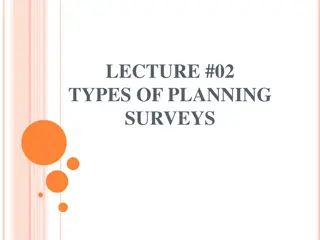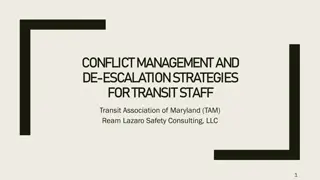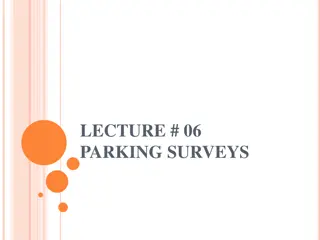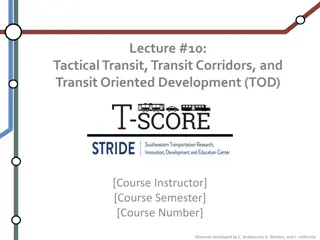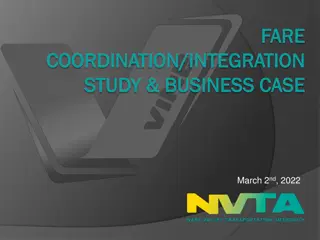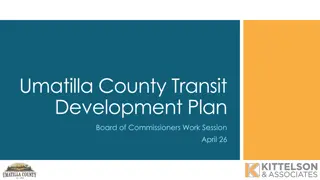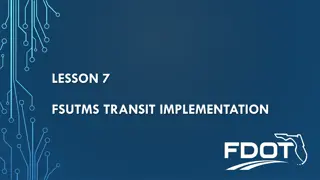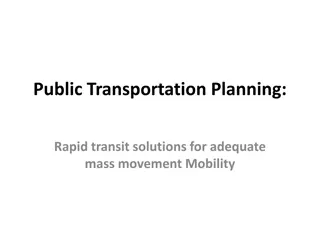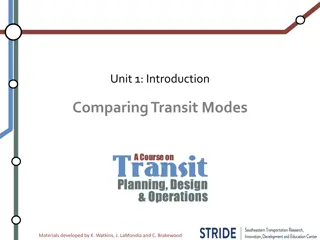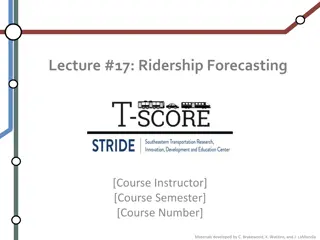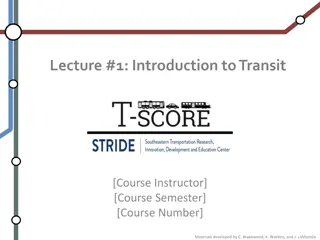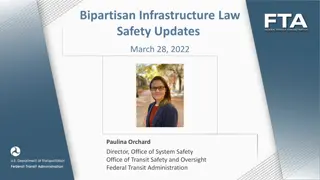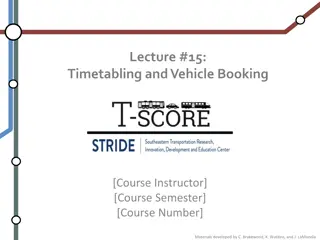Initial Analysis of Transit Rider Surveys
This analysis delves into sampling rates for transit rider surveys, exploring motivations, traditional practices, market investigations, sample size calculations, and detailed data on AM-peak trip flows. The study emphasizes the importance of accurate sample sizes in understanding transportation patterns and market dynamics.
Download Presentation

Please find below an Image/Link to download the presentation.
The content on the website is provided AS IS for your information and personal use only. It may not be sold, licensed, or shared on other websites without obtaining consent from the author.If you encounter any issues during the download, it is possible that the publisher has removed the file from their server.
You are allowed to download the files provided on this website for personal or commercial use, subject to the condition that they are used lawfully. All files are the property of their respective owners.
The content on the website is provided AS IS for your information and personal use only. It may not be sold, licensed, or shared on other websites without obtaining consent from the author.
E N D
Presentation Transcript
Sampling Rates for Transit Rider Surveys An Initial Analysis 1
Motivations FTA requirements for rider surveys Model development for project forecasts Before-and-After Studies of complete projects Another frequently asked question: What is the necessary sample size/rate? FTA response, so far 10 percent average seems to have been adequate Less for larger systems; more for smaller systems 2
Traditional practice Sample size determined by: Often, rule-of-thumb uniform rate 10% Sometimes: nominal sample-size computation of required sample for individual routes But, computations are often: Aggregate all trips on a route Absent scrutiny of components: time period, direction Largely invariant in number of samples across routes Absent attention to actual statistical significance 3
An investigation into markets Design AM-peak sample for each rail station Use faregate counts of station-to-station trips Compute sample needed to characterize: Flows between stations because transportation is about moving people from here to there Number of trips from each entry station: To exits aggregated into 20 station groups For three income classifications Given accuracy requirements (95%; 10 percent ) 4
MetroRail map and station groups Vienna Station Congress Heights Station 5
Sample-size calculation 1 2 ? 1 ?(1 ?) ? ? = ? 1 + ?? Where: n = sample size N = total population P = the proportion of riders in each ridership market to the total number of riders. This proportion depends on the level of data known (i.e., the total number of riders can either refer to total station entries or station group flows, if flows are known). d = allowable margin of error (i.e. d=0.10 for +/-10%) Z = value of the cumulative normal for a Type I error probability of (Z-score based on confidence level) And sample is assumed to be unbiased 6
Known: AM-Peak trip flows from Vienna station Need to know: flows by income class Trips by income class from Vienna station to each station group (to be estimated from survey data) Trips from Vienna station to each station group (known from fare-gate data) Vienna Station 10,388 Entries AM-Peak 7
Sample calculations: large flow Vienna station to Rosslyn-CapitolSouth group Necessary Samples of Entries at Vienna Station Exit Station Group Income Class Assumed Percent Required Exit Samples Required Exit Samples 95 Rosslyn through Capitol South (inclusive) L 50% 95 Vienna-to-Group Exits 5,069 M 25% 72 Exit-Group Sampling Rate 1.9% H 25% 72 Required Entry Samples 196 Total 100% 95 For 95 percent confidence and a 10 percent interval Worst-case assumption for income distribution: 50% in one cell Required samples = max, not sum, across income groups Required exit sampling rate is very small because N is very large 8
Sample calculations: medium flow Vienna station to Archives-L Enfant group Necessary Samples of Entries at Vienna Station Exit Station Group Income Class Assumed Percent Required Exit Samples Required Exit Samples 82 Archives through L Enfant Plaza (inclusive) L 50% 82 Vienna-to-Group Exits 550 M 25% 64 Exit-Group Sampling Rate 14.9% H 25% 64 Required Entry Samples 1,540 Total 100% 82 For 95 percent confidence and a 10 percent interval Compared to largest exit-station group: Required exit samples slightly less, but group exits much less So, exit sampling rate is much higher, though still plausible Entry samples will include large over-samples from larger exit groups 9
Sample calculations: small flow Vienna station to ShadyGrove-Grosvenor group Necessary Samples of Entries at Vienna Station Exit Station Group Income Class Assumed Percent Required Exit Samples Required Exit Samples 16 Franconia through Huntingtn (inclusive) L 50% 16 Vienna-to-Group Exits 18 M 25% 15 Exit-Group Sampling Rate 88.9% H 25% 15 Required Entry Samples 8,077 Total 100% 16 For 95 percent confidence and a 10 percent interval Compared to largest exit-station group: Required exit samples decline, but approach number of group exits So, exit sampling rate approaches 100% Entry samples will include huge over-samples from larger exit groups 10
Initial observations (1) Sampling rate for entry station driven (to nearly 100%) by exit station-group with smallest exit flows unrealistic Possible response Specify the scope of the accuracy requirement Confidence: 95% Margin of error: 10% Scope: at least 80% of entries 11
Scope of the accuracy specification Conf = 95% MOE =10% Characteristics # of Entry Samples Exit Groups Sorted by Exit Volume Flow #Samp Samp% Scope% Rosslyn-CapSouth 5,069 95 1.9% 49% 196 Dupont-Union.Sta 1,860 92 4.9% 67% 507 E.Falls.Ch-Ct.House 1,006 88 8.7% 77% 899 Vienna Station Nat.Arpt-Arl.Cem 712 85 11.9% 84% 1,230 Archives-L Enfant 550 82 14.9% 90% 1,540 Vienna-W.Falls.Ch 261 71 27.2% 92% 2,812 Congr.Hts-Wfront 189 64 33.9% 93% 3,505 : : : : : : : : : : : : Franc-Huntington 18 16 88.9% 99.9% 9,189 Benning.Rd-Largo 4 4 100.0% 100.0% 10,338 Total exits 10,338 --- --- --- --- 12
Scope of the accuracy specification Conf = 95% MOE =10% Characteristics # of Entry Samples Exit Groups Sorted by Exit Volume Flow #Samp Samp% Scope% Dupont-UnionSta. 272 72 26.5% 18% 272 Rosslyn-CapSouth 252 70 27.8% 35% 528 Archives-L Enfant 213 67 31.5% 49% 739 Congress Heights Station NY Ave.-Takoma 133 57 42.9% 58% 875 Georgia Ave.-U St. 107 51 47.7% 65% 981 Congress Hts.-Wfnt 91 47 51.6% 71% 1071 : : : : : : : : : : : : SilverSpr.-Glenmont 18 16 88.9% 98% 1,479 Benning Rd.-Largo 16 14 87.5% 99% 1,494 Franc-Huntington 11 10 90.9% 100% 1,509 Total exits 1,509 --- --- --- --- 13
Initial observations (2) Required sampling rate increased by worst- case assumption on income distribution Possible response Find some data on income distributions previous rider survey? Compute income distribution of trips entering each stations 14
Initial observations (3) Uniform sampling rate for all entries at station: Oversamples large flows Under-samples others Get lots of records from small flows that have no statistical significance Possible response: sample at different rates Compute rate for each within-scope exit-group Decide what to do about small-flow cells Set upper limits on large-flow cells Pre-screen riders in the field 15
Sampling quotas by exit group Contacts Conf = 95% MOE =10% Characteristics # of Entry Samples Exit Groups Sorted by Exit Volume Flow #Samp Samp% Scope% Rosslyn-CapSouth 5,069 95 1.9% 49% 196 Dupont-Union.Sta 1,860 +92 4.9% 67% 507 E.Falls.Ch-Ct.House 1,006 +88 8.7% 77% 899 Vienna Station Nat.Arpt-Arl.Cem 712 +85 11.9% 84% 1,230 Archives-L Enfant 550 82 14.9% 90% 1,540 Vienna-W.Falls.Ch 261 71 27.2% 92% 2,812 Congr.Hts-Wfront 189 64 33.9% 93% 3,505 : : : : : : : : : : : : Franc-Huntington 18 16 88.9% 99.9% 9,189 Benning.Rd-Largo 4 4 100.0% 100.0% 10,338 Total exits 10,338 --- --- --- --- 16
Experimental design Obtain station-to-station counts Plus, find external data on income? Case 2 Plus, apply quotas by exit group? And Specify confidence level = 95% Specify margin of error Specify scope Case 1 Case 3 = varies within each case = varies within each case 17
Caution on Margins of Error Sample A: MOE = 10% To CBD % low inc. To non-CBD % low inc. Sample B: MOE = 30% To CBD % low inc. To non-CBD % low inc. Sample mean Sample with 10% MOE is able to differentiate average incomes between two populations while a sample with 30% MOE from the same populations cannot. Bounds 18
Confidence level is 95 percent Scope Case 2 Case 3 Case 1 Illustration on slide 14 19
Confidence level is 95 percent Scope Case 1 Case 2 Case 3 20
Outcomes for All Entry Stations (Case 1) Specifications: - Confidence level = 95% - Margin of error = 10% Congress Heights System required average sampling rate = 36% - Scope = 80% Consequences - Required Samples = 95,751 - System-wide Sampling Rate = 41% Vienna 21
Outcomes for All Entry Stations (Case 3) Specifications: - Confidence level = 95% - Margin of error = 10% - Scope = 80% Consequences - Required Samples = 95,751 - System-wide Sampling Rate = 22% Congress Heights Vienna 22
Yikes! What do we do? In sample design, consider 1. Adopting Case 3 strategy (on-to-off data, quotas, prior data) 2. Loosening accuracy requirement (95% 90%?) 3. Identifying priority data needs 4. Further aggregating exit-station-groups 5. Avoiding interviews with too-small exit-station-groups 6. Shifting effort saved with quotas to smaller-volume stations 7. Dropping hopelessly small entry-stations (?!) 8. Recognizing that some markets are beyond reach 9. Ensuring that the budget is realistic given stated data needs 23
Yikes! What do we do? (continued) In using the data, 1. Recognize varying levels of accuracy for different markets 2. Convey the level of accuracy to others 3. Recognize that N-dimensional cross-tabulations (N 3) are likely to reflect statistically insignificant information 24
Conclusions Traditional practice appears na ve Aggregate computations overstate accuracy outcome Uniform sampling rates ignore individual markets Large markets may well be over-sampled Small markets may be beyond reach, statistically Instruments are just one aspect, not the primary one Sample design needs more attention On-to-off data to define the sampling frame Levels of aggregation that recognize market sizes New methods in the field to make best use of budget 25
Thank you. Questions? 26




